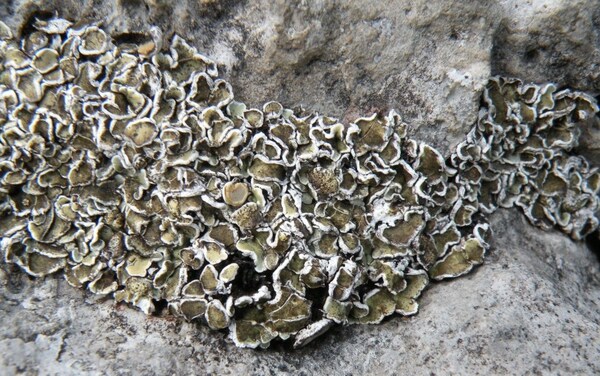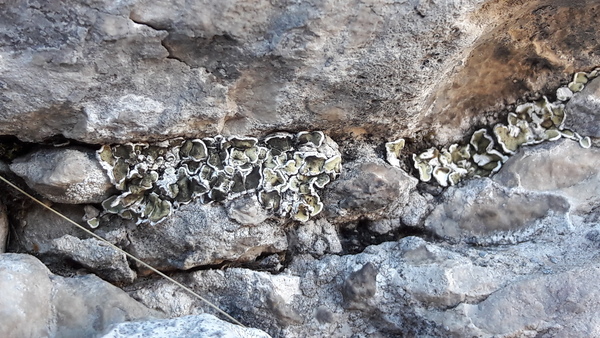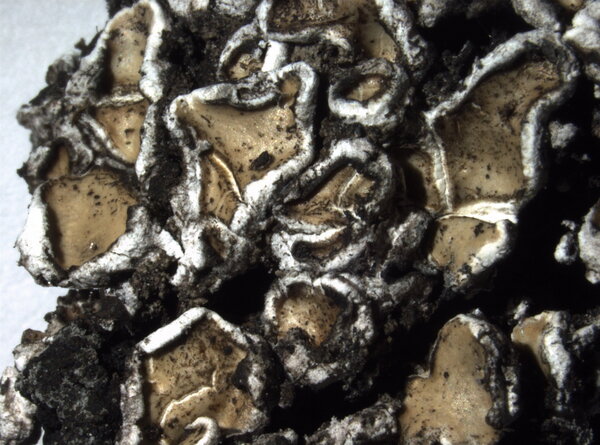Squamarina subcetrarioides (Zahlbr.) Y.Y. Zhang
in Zhang & al., Lichenologist, 55: 135, 2023. Basionym: Lecanora fragilis var. subcetrarioides Zahlbr. - Ann. naturhist. Mus. Wien, 38; 143, 1925
Synonyms: Squamarina gypsacea var. subcetrarioides (Zahlbr.) Pišút
Description: Thallus squamulose to crustose-placodioid, greenish, initially forming 2-7 cm wide, well-delimited rosettes which are continuous and usually epruinose in central parts, deeply and frequently lobed in peripheral parts, the margin of lobes strongly white-pruinose; mature thalli irregular in outline, becoming transversely cracked, with numerous small, white-rimmed, dissected squamules; lower surface pale, white to pale brown, with scattered, dark brown to black, simple, fragile rhizinoid strands. Upper cortex 45-55 μm thick, inspersed with pale brown granules dissolving in K, overlain by a thin epinecral layer; medulla white, thick, filled with calcium oxalate crystals; lower cortex absent. Apothecia lecanorine, common only in the mature, more squamulose thalli, scattered, rounded, 2-6 mm across, with a pale ochraceous, faintly white-pruinose, slightly concave disc and an entire, partly pruinose, usually persistent thalline margin. Cortex of thalline margin similar to the upper cortex of thallus; epithecium 10-17 μm high, with pale brown granules dissolving in K and calcium oxalate crystals; hymenium colourless, 75-85 μm high, with pale brown granules dissolving in K, hemiamyloid; paraphyses simple, c. 2 μm thick; subhymenium 20-27 μm high, with clusters of calcium oxalate crystals; hypothecium 150-200 μm high, with pale brown granules dissolving in K, not subtended by an algal layer. Asci 8-spored, elongate-clavate, with a thin, outer amyloid layer and a thickened, amyloid tholus devoid of an ocular chamber, penetrated by an axial tube the sides of which stain I+ deeper blue, approaching the Porpidia-type, 57-75 x 10-15 μm. Ascospores 1-celled, hyaline, subfusiform to ellipsoid, 11-17 x 5-7 μm. Photobiont chlorococcoid. Spot tests: cortex K-, C-, KC- or KC+ yellowish, P-, UV-; medulla P+ yellow. Chemistry: cortex with isousnic and usnic acid, medulla with psoromic and 2ʹ-O-demethylpsoromic acids.
Growth form: Squamulose
Substrata: rocks
Photobiont: green algae other than Trentepohlia
Reproductive strategy: mainly sexual
Commonnes-rarity: (info)
Alpine belt: rather rare
Subalpine belt: rare
Montane belt: extremely rare
Dry submediterranean belt: absent
Humid submediterranean belt: absent
Padanian area: absent
pH of the substrata:
1 2 3 4 5
Solar irradiation:
1 2 3 4 5
Aridity:
1 2 3 4 5
Eutrophication:
1 2 3 4 5
Poleotolerance:
0 1 2 3
Altitudinal distribution:
1 2 3 4 5 6
Rarity
absent
extremely rare
very rare
rare
rather rare
rather common
common
very common
extremely common
Loading data...
Occurrence data
Predictive map

Gabriele Gheza; Owner: Gabriele Gheza
Italy, Lombardia, Corna di San Fermo, nel gruppo del Pizzo Camino (ValCamonica).
Herbarium: Forum Natura Mediterraneo
2010
Growth form: Squamulose
Substrata: rocks
Photobiont: green algae other than Trentepohlia
Reproductive strategy: mainly sexual
Commonnes-rarity: (info)
Alpine belt: rather rare
Subalpine belt: rare
Montane belt: extremely rare
Dry submediterranean belt: absent
Humid submediterranean belt: absent
Padanian area: absent
pH of the substrata:
| 1 | 2 | 3 | 4 | 5 |
Solar irradiation:
| 1 | 2 | 3 | 4 | 5 |
Aridity:
| 1 | 2 | 3 | 4 | 5 |
Eutrophication:
| 1 | 2 | 3 | 4 | 5 |
Poleotolerance:
| 0 | 1 | 2 | 3 |
Altitudinal distribution:
| 1 | 2 | 3 | 4 | 5 | 6 |
Rarity
absent
extremely rare
very rare
rare
rather rare
rather common
common
very common
extremely common
Loading data...
Occurrence data
Predictive map










